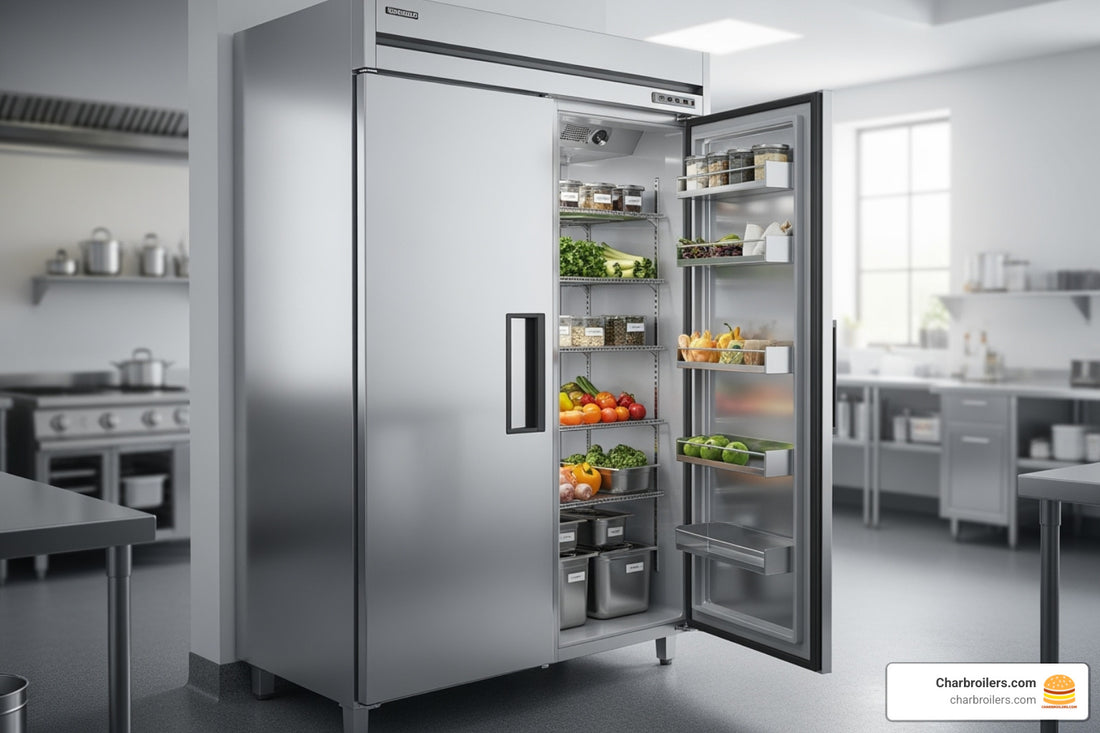
The Price of Cool: A Guide to Commercial Refrigerator Costs
Share
Understanding the True Investment in Commercial Refrigeration
The commercial refrigerator price can range from $1,800 for basic reach-in units to over $10,000 for high-end models, but the sticker price is just the beginning of your total investment.
Quick Price Overview:
- Reach-in refrigerators: $1,800 - $7,000
- Walk-in coolers: $5,000 - $15,000+
- Undercounter units: $1,200 - $3,500
- Prep tables with refrigeration: $800 - $2,500
Choosing the right commercial refrigerator is about understanding the total cost of ownership—which includes energy bills, maintenance, repairs, and the unit's lifespan. While you might save money upfront with a basic model, factors like energy efficiency and build quality dramatically impact long-term costs. A cheaper unit that breaks down or drives up your electric bill can end up costing you thousands more than a quality investment.
Key factors that drive commercial refrigerator pricing include:
- Size and capacity
- Construction materials (stainless steel vs. aluminum)
- Energy efficiency ratings
- Brand reputation and warranty
- New vs. used condition
- Type of refrigeration system
I'm Sean Kearney from Charbroilers.com. With over a decade in the restaurant equipment industry, I've helped countless owners make smart decisions that fit their budget and operational needs. Understanding these cost factors upfront can save you thousands in the long run.
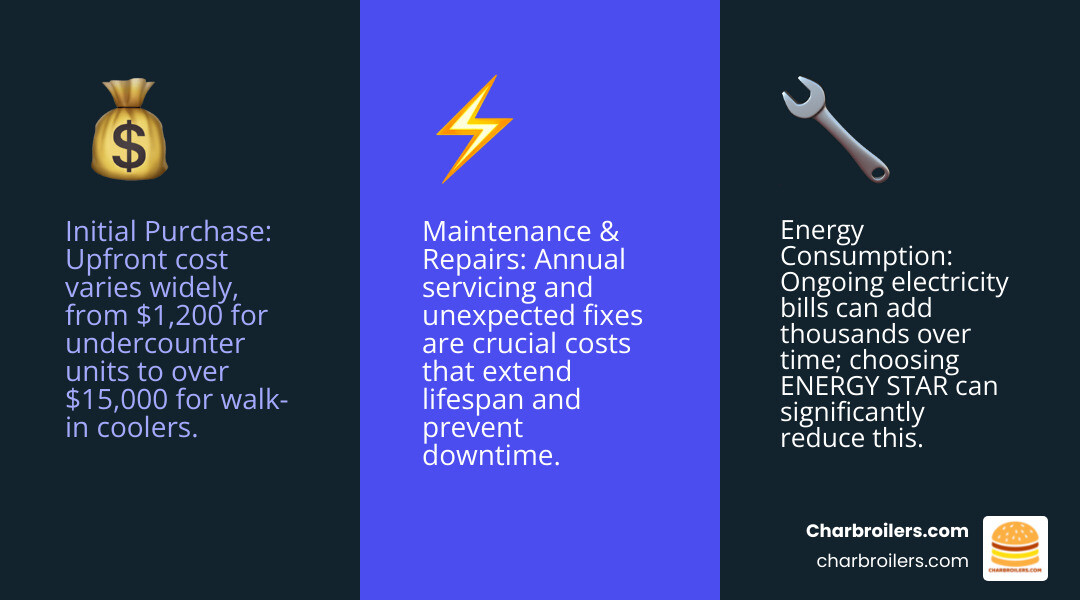
Easy commercial refrigerator price word list:
Decoding the Average Commercial Refrigerator Price
Commercial refrigerator price tags can seem all over the map, but there's a method to it. Understanding the typical ranges helps you set a realistic budget.
The average commercial refrigerator price falls between $2,500 to $7,000, though quality options exist below this range and premium models climb above $10,000. This spectrum reflects the variety of units designed for different kitchen needs, from compact undercounter models to massive walk-in systems.
For example, a solid door reach-in refrigerator can start around $1,800, while a well-built single-section unit with 23.0 cu. ft. capacity might run about $2,525 with free shipping. The key is matching your budget to your operational needs, as a busy pizza kitchen has different requirements than a small café.
Price Ranges by Refrigerator Type
Each type of refrigerator is engineered for specific kitchen roles, which directly impacts its cost.
Reach-in refrigerators are the backbone of most kitchens. Single-door models typically start around $1,800 to $2,500, while larger multi-door units can reach $7,000 or more. They're perfect for daily ingredient storage with easy access.
Walk-in coolers are a major investment. These refrigerated rooms require custom sizing and powerful systems. A basic setup starts around $5,000 but commonly exceeds $15,000 depending on size and features.
Undercounter units maximize tight spaces by fitting beneath countertops. Expect to invest between $1,200 to $3,500, with pricing influenced by size and features.
Prep tables with refrigeration combine workspace with cold storage. These dual-purpose units typically range from $800 to $2,500, varying with length and pan capacity.
Merchandisers are designed to showcase products through glass doors. These units range from $1,500 for smaller models to over $6,000 for large or specialized designs.
Bar refrigerators serve beverage needs, including bottle coolers and back bar units. These typically cost between $1,000 to $4,000.
For a comprehensive comparison, check out our Detailed Guide to Comparing Commercial Refrigerators.
What Influences the Average Commercial Refrigerator Price?
Several key factors determine your final commercial refrigerator price.
Size and capacity have the most obvious impact. A unit with greater cubic footage costs more due to more materials and larger components.
Brand tier plays a significant role. Established manufacturers with proven track records and solid warranties command higher prices.
Features and technology like digital controls, LED lighting, and self-cleaning condensers add convenience and efficiency, but also to the price tag.
Construction materials impact both price and longevity. Stainless steel costs more than aluminum but offers superior durability and easier cleaning.
New versus used condition creates the biggest price differential. A used unit can be significantly cheaper upfront, but a new one offers reliability and a full warranty.
Key Factors That Drive Up or Down the Cost
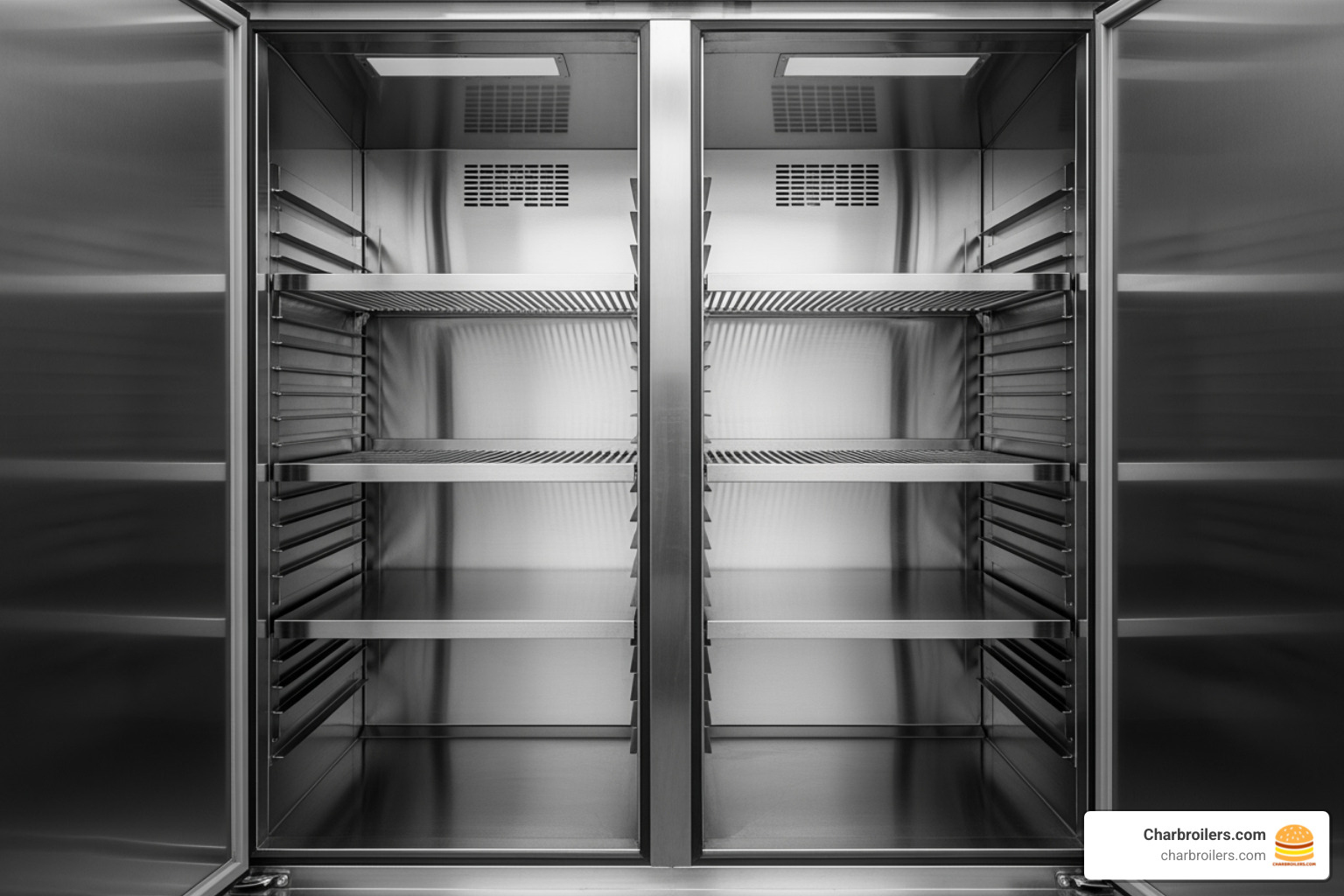
Understanding what drives the commercial refrigerator price up or down can save you thousands. It's about knowing which features matter for your operation and which ones are expensive add-ons without real value.
Size, Capacity, and Construction Materials
The physical footprint and storage capacity, measured in cubic feet (cu. ft.), directly impact what you'll pay. A compact undercounter unit might offer 6-12 cu. ft., while a three-section reach-in could have 70+ cu. ft. More space means more materials and a bigger compressor, increasing the commercial refrigerator price. The number of doors also affects pricing, as each additional door adds hardware and complexity.
Materials are a key price differentiator. Stainless steel is the gold standard for durability and ease of cleaning, making it the most expensive option. Many quality units, like the Avantco A-49R-HC, feature stainless steel exteriors. Aluminum is a more affordable middle ground, often used for interiors. Galvanized steel is the budget option, typically found on rear or bottom panels where appearance is less critical.
Features, Technology, and Energy Efficiency
Modern features can significantly impact the commercial refrigerator price, but they often pay for themselves through savings and easier operation.
- Digital controls and LED displays offer precise temperature management for food safety compliance.
- LED interior lighting uses less energy, produces less heat, and illuminates contents better than older bulbs.
- Self-cleaning condensers automatically remove dust buildup that kills efficiency and leads to expensive repairs. The Avantco A-49R-HC, for example, has a robust 1/2 hp compressor that benefits from this feature.
- Eco-friendly refrigerants like R-290 propane have a lower environmental impact and often improve energy efficiency, as seen in models like the Everest Refrigeration ESR1.
ENERGY STAR certification is a crucial factor. These units typically cost more upfront but can slash your electric bills over the unit's lifetime. When running refrigeration 24/7, those savings add up fast. For units that meet industry standards, our Cool Compliance: Your Guide to NSF/ANSI Standard 7 for Refrigerators and Freezers explains the certifications you'll find on higher-quality equipment.
Refrigeration System: Self-Contained vs. Remote
The type of refrigeration system affects both initial price and ongoing costs.
Self-contained units have all components within the cabinet, making them simple to install (often just plug-and-play) and keeping the initial commercial refrigerator price predictable. The downside is they release heat and noise into your kitchen, making your AC work harder.
Remote systems locate the noisy, heat-producing components elsewhere, like on the roof. This is common for walk-in coolers and results in a cooler, quieter kitchen and often better efficiency. However, the installation is far more complex and expensive, requiring professional setup of refrigerant lines and electrical connections. The trade-off is between higher upfront costs and a better long-term working environment.
New vs. Used: A Cost-Benefit Analysis
Deciding between a new and a used commercial refrigerator is a classic battle between saving money now versus investing in long-term reliability. Understanding the real differences in commercial refrigerator price, lifespan, and hidden costs is key.
| Feature | New Commercial Refrigerator | Used Commercial Refrigerator |
|---|---|---|
| Price | Higher upfront cost (e.g., $1,800 - $10,000+) | Significantly lower upfront cost (often 30-70% less) |
| Lifespan | Full expected lifespan (typically 10-15 years) | Reduced lifespan, depends on age and previous use |
| Warranty | Full manufacturer's warranty (parts, labor, compressor) | Often no warranty, or very limited (e.g., 30-90 days) |
| Technology | Latest energy efficiency, features, and refrigerants | Older technology, potentially less efficient or feature-rich |
| Reliability | High, less prone to immediate breakdowns | Variable, higher risk of unexpected repairs |
| Energy Costs | Lower, thanks to modern efficiency standards | Potentially higher, due to older components and less efficient design |
| Customization | Full range of options and configurations available | Limited to what's currently on the market |
The Upfront Savings of Used Refrigerators
Used refrigerators offer immediate relief from sticker shock, often costing 30% to 70% less than new models. For a startup or a business on a tight budget, this can free up capital for other critical needs. You can find them through equipment auctions, dealers, or online marketplaces.
However, that lower commercial refrigerator price doesn't tell the whole story. What you save upfront could be spent later on unexpected repairs, higher energy costs, or a breakdown during a dinner rush. A well-maintained, five-year-old unit from a reputable brand could be a smart buy, but a ten-year-old mystery machine is a gamble.
The Hidden Risks and Long-Term Value of New Units
When you invest in a new commercial refrigerator, you're buying reliability and peace of mind. The higher initial commercial refrigerator price gets you significant advantages.
Warranty coverage is the biggest benefit. New units come with manufacturer warranties covering parts, labor, and the compressor, protecting you from costly surprise repairs.
A full expected lifespan of 10-15 years means you can spread your investment over a decade, making the upfront cost more reasonable when broken down over time.
Modern technology and energy efficiency in new units can slash your monthly energy bills. Over the unit's life, these savings can often exceed the higher initial price.
Most importantly, you avoid the immediate repair headaches that can plague used equipment, allowing you to focus on your business. At Charbroilers.com, we believe in investments that pay off long-term. Explore our full range at Shop Commercial Refrigerators Online | Charbroilers.com.
Beyond the Sticker Price: Ongoing Costs and Total Cost of Ownership
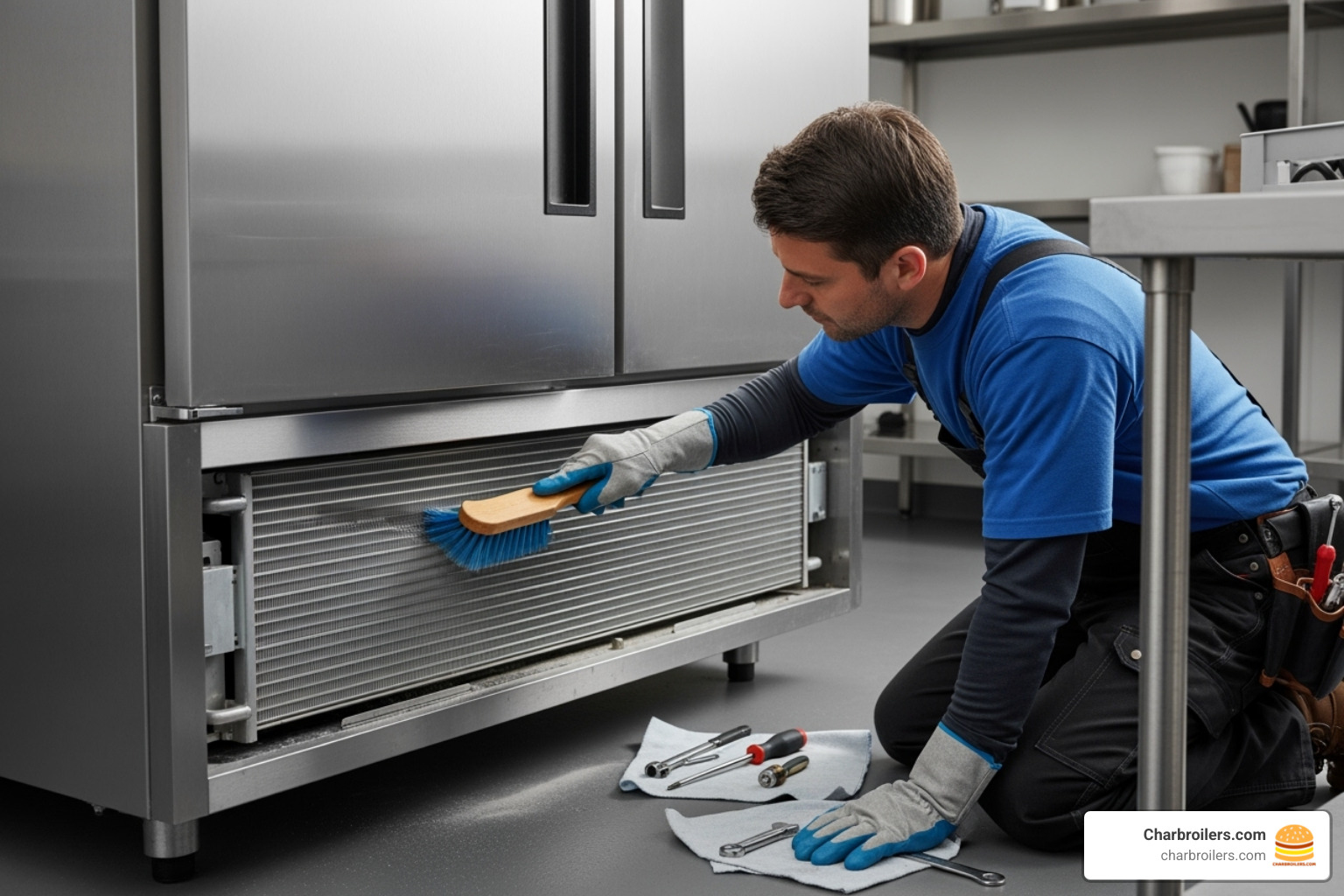
The commercial refrigerator price you see on the sticker is just the entry fee. Over its 10 to 15-year lifespan, your refrigerator will accumulate costs through energy bills, maintenance, and repairs. Understanding the total cost of ownership is essential for keeping your operation profitable.
Energy Consumption: The Silent Expense
Your commercial refrigerator runs 24/7, making energy consumption a major ongoing expense. An older, inefficient unit can consume 30-50% more electricity than a modern model, which adds up on your monthly bills.
ENERGY STAR certification is your best tool for finding an efficient model. While an ENERGY STAR unit might have a higher initial commercial refrigerator price, the monthly utility savings can quickly make up the difference. For example, a basic refrigerator might seem like a bargain, but if it costs an extra $50 per month in electricity compared to an efficient model, that "deal" will cost you an additional $3,000 in energy over just five years.
Most product specifications include estimated annual energy consumption. Multiply that by your local electricity rate to get a clearer picture of what a unit will really cost you over its lifetime.
Maintenance, Repairs, and Lifespan
Regular maintenance and occasional repairs are facts of life that impact your total investment. Annual maintenance costs typically run a few hundred dollars per visit but act as insurance against bigger problems like failed motors, worn door seals, or thermostat malfunctions.
Average repair costs can range from a few hundred dollars to over $1,000 for major component replacements like a compressor. The typical lifespan of a well-maintained commercial refrigerator is 10 to 15 years. Quality construction and regular maintenance are key to longevity.
When facing a repair on an older unit, use the 50% rule: if the repair costs more than half the price of a new unit, replacement usually makes more sense. A 10-year-old refrigerator is approaching the end of its life and is likely less efficient. Our Commercial Refrigerator Repair Cost Guide offers more detailed guidance.
Warranty Considerations and Their Impact on Price
A solid warranty is a financial safety net. Parts and labor warranties typically cover you for 1 to 3 years. Compressor warranties are especially important, as the compressor is the most expensive component to replace; these often extend for 5 years.
Read the warranty details carefully to understand what's covered and what actions might void it. While strong warranty support might slightly increase the initial commercial refrigerator price, the protection it offers against devastating repair bills is almost always worth it.
Frequently Asked Questions about Commercial Refrigerator Prices
Here are answers to the most common questions we hear at Charbroilers.com about commercial refrigeration costs.
What is a realistic budget for a small restaurant's first commercial refrigerator?
For a small restaurant, a single or double-door reach-in is a common starting point. Budgeting between $2,000 and $5,000 will get you a solid, reliable new unit. For example, a workhorse model like the Everest ESR1 costs around $2,500 and offers 23.0 cu. ft. of storage, which is ample for a small operation. Don't opt for the cheapest model just to save a few hundred dollars upfront; reliability and proper temperature control will save you money and headaches in the long run.
How much more expensive are walk-in coolers compared to reach-in refrigerators?
Walk-in coolers are in a different price universe. While a high-end reach-in might cost around $7,000, a walk-in cooler is a refrigerated room. Starting costs for a small walk-in system are around $5,000, but most installations easily exceed $15,000. The commercial refrigerator price jump is due to the need for insulated panels, a powerful refrigeration system, professional installation, and custom sizing, which often involves running refrigerant lines and electrical work.
Is it cheaper to repair or replace a 10-year-old commercial refrigerator?
As a general rule, if a repair costs more than 50% of a new, comparable unit, it's time to replace it. With a 10-year-old unit, you're already near the end of its typical 10-15 year lifespan, so more issues are likely on the horizon. Furthermore, a decade-old unit is far less energy-efficient than a modern ENERGY STAR model. The long-term energy savings from a new unit can often justify the replacement cost, not to mention the peace of mind that comes with a new warranty.
Conclusion
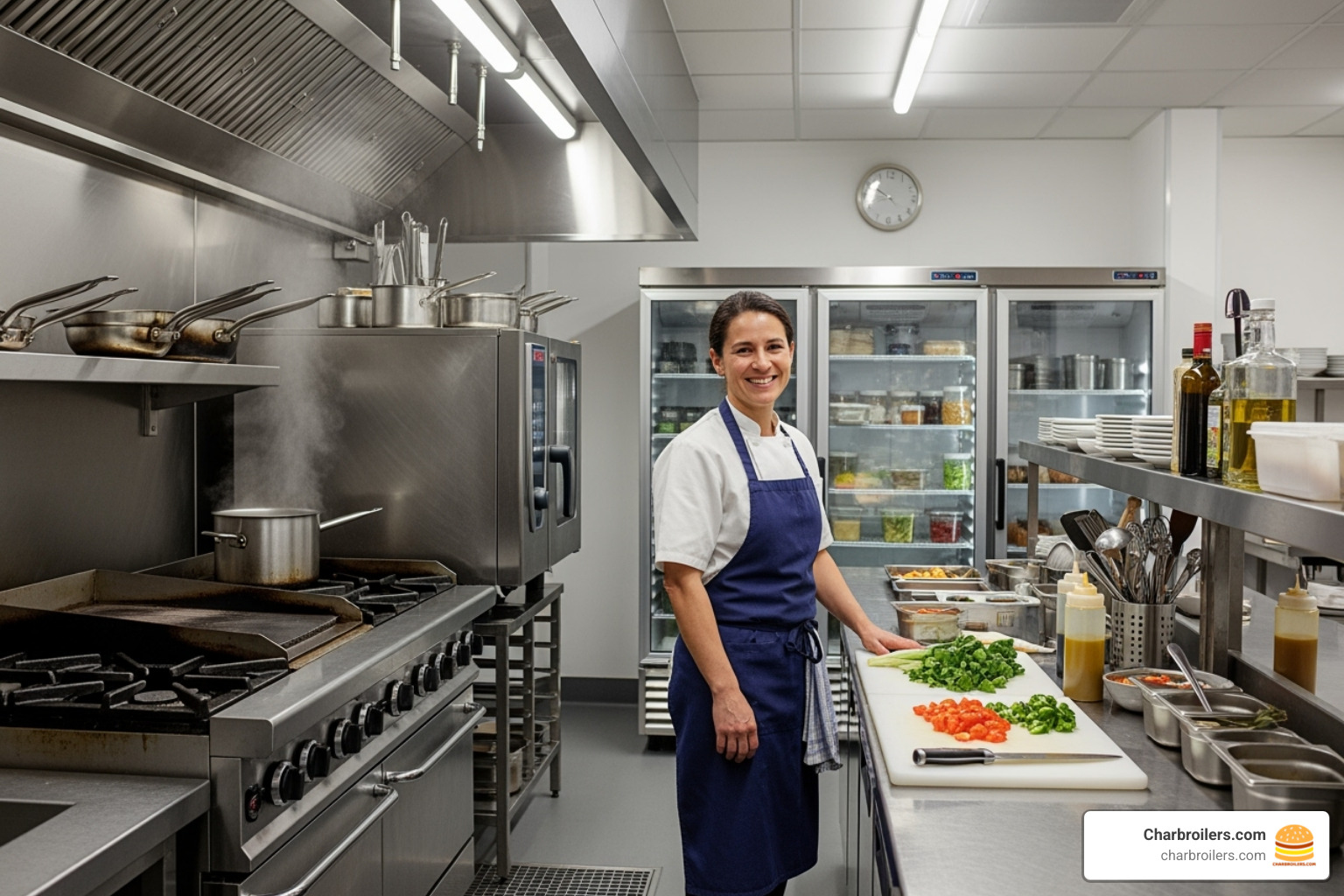
When it comes to commercial refrigerator price, the sticker price is just the beginning. The true investment is the total cost of ownership, which includes long-term expenses for energy, maintenance, and repairs.
Here are the key takeaways:
- Price is determined by size, materials, features, and brand.
- New vs. Used is a trade-off between upfront savings and long-term reliability and warranty coverage.
- Energy consumption is a major hidden cost. An efficient model saves you money every month.
- Maintenance and warranties are essential for protecting your investment and avoiding costly downtime.
At Charbroilers.com, we understand that every dollar matters. That's why we offer financing options custom for food service operations, making it easier to invest in quality equipment. We're not just selling you a refrigerator; we're helping you build a foundation for success.
As you plan your cold storage, remember the other essential equipment that completes your kitchen. Our Commercial Refrigeration Equipment Explained: No Sweat guide offers more insights to keep your operation running smoothly. Your kitchen deserves equipment that works as hard as you do, and we're here to help you make that happen.
